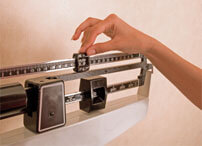Weight Management

Weight Management Overview
How do some people lose weight and keep it off? How do some people avoid the natural tendency to gain weight as they age? If you have achieved your weight loss goals, or if you didn't achieve your goals, but want to keep your weight in a healthy range, consider these recommendations from the National Weight Control Registry. This is a program for weight management over a lifetime, from the National Institutes of Health. Focus on health, not weight. Which is more important to you – being able to wear the jeans you wore five years ago, or being able to move better, have more energy, and improve your health? Losing weight for health, rather than appearance, can make it easier to set reasonable and realistic goals.
These are some guidelines to monitor your weight:
- You should achieve or maintain a body mass index (BMI) between 18.5 and 24.9.
- Your waist should measure less than 40 inches if you are a man, or less than 35 inches if you are a woman. Fat stored around your waist increases your risk for chronic conditions, such as heart disease and diabetes.
Subtract 100
Have a plan for how to get back on track if your weight begins to creep up. The plan does not have to include extreme measures. By cutting out only 100 calories a day and increasing your physical activity, you may be able to reverse weight gain and return to your goal weight.
Balance calories in, calories out
Try not to eat more calories than your body burns each day. Stick to your eating plan, even on weekends, vacations, and holidays. If you eat more calories than you need, the excess calories are stored as fat. Too much stored fat raises your BMI and makes it hard to get back to your goal weight. Remember that the number of calories you need each day depends on your age, gender, and activity. To get an estimate of the number of calories you need, visit the United States Department of Agriculture's Choose My Plate.
Pick wholesome foods

You should get the calories you need by eating foods that give you plenty of nutrients. Focus on a healthy eating plan that matches your level of physical activity and include a variety of nutritional food choices.
Grains: Each day, you need approximately 6 to 8 servings, half of which should be whole grains. Any of these is a typical serving size:
- 1 slice of bread
- 1/2 medium bagel
- 1 medium muffin (homemade size)
- 1 ounce dry cereal, or 1/2 cup cooked cereal, pasta, or rice
Fruits: You need approximately 2 to 3 servings per day. Any of these is a typical serving size:
- 1 medium piece of fruit (apple, banana, or orange)
- 1/2 cup chopped fruit
- 1/2 cup juice
Vegetables: You need approximately 3 to 5 servings per day. Any of these is a typical serving size:
- 1 cup raw leafy vegetables
- 1/2 cup other vegetables, cooked or chopped raw
Dairy: You need 2 cups of milk or other dairy products every day. Any of these is a typical serving size:
- 1 cup milk or yogurt
- 1-1/2 ounces natural cheese
- 2 ounces processed cheese
Meat: You need approximately 6 to 8 ounces of meat per day. Any of these is a typical serving size:
- 2 to 3 ounces cooked, lean meat, poultry, or fish
- 1 cup cooked or canned beans
- 1 egg or 2 tablespoons peanut butter equal 1 ounce of lean meat
Watch portion sizes
It is not only the types of foods that are important, but also the size of the portions you eat.
Figuring out serving sizes doesn't require complex weights and measures. Use these everyday examples to help you gauge what is on your plate:
- 1/2 cup cooked rice is the size of an ice cream scoop
- 1 cup dry cereal is the size of a large handful
- 1 medium-sized piece of fruit is the size of a baseball
- 1 cup vegetables is the size of your fist
- 1-1/2 ounces cheese is the size of a pair of dominoes or dice
- 3 ounces meat or fish is the size of a deck of cards or your palm
- 1 teaspoon butter or margarine is the size of the tip of your thumb
Get motivated to move
By definition, a healthy lifestyle includes exercise. Exercise burns calories and builds muscle. It's also good for your heart and lungs and can help improve your mood. Try to watch fewer than 10 hours of TV per week. When you do watch, try to exercise during commercial breaks instead of snacking, or walk on a treadmill while you watch.
Both aerobic exercises (brisk walking, jogging, cycling) and strengthening exercises (calisthenics, weight training) are important for weight management. Vigorous exercise burns the highest number of calories and provides the greatest cardioprotective benefits. Try to build up to at least 30 minutes of aerobic exercise five or more days a week. If you are unable to engage in vigorous exercise, always remember some physical activity is better than nothing. For instance, brisk walking is a good type of exercise that provides caloric expenditure and helps build stronger bones. To build muscle, include two or three strength-building sessions a week. Building muscle can speed up your metabolism. This can help you burn more calories. Be sure to check with your health care provider before beginning an exercise program.
Stay motivated by trying new activities, such as dancing, hiking, or martial arts. If you don't always have time to exercise, you can still find plenty of opportunities to burn calories: Take the stairs instead of the elevator, walk briskly rather than strolling. Any additional activity you can add to your day will make a difference.



